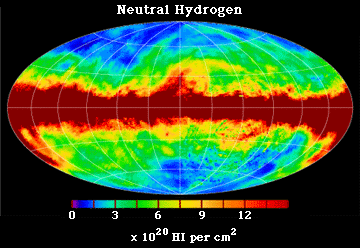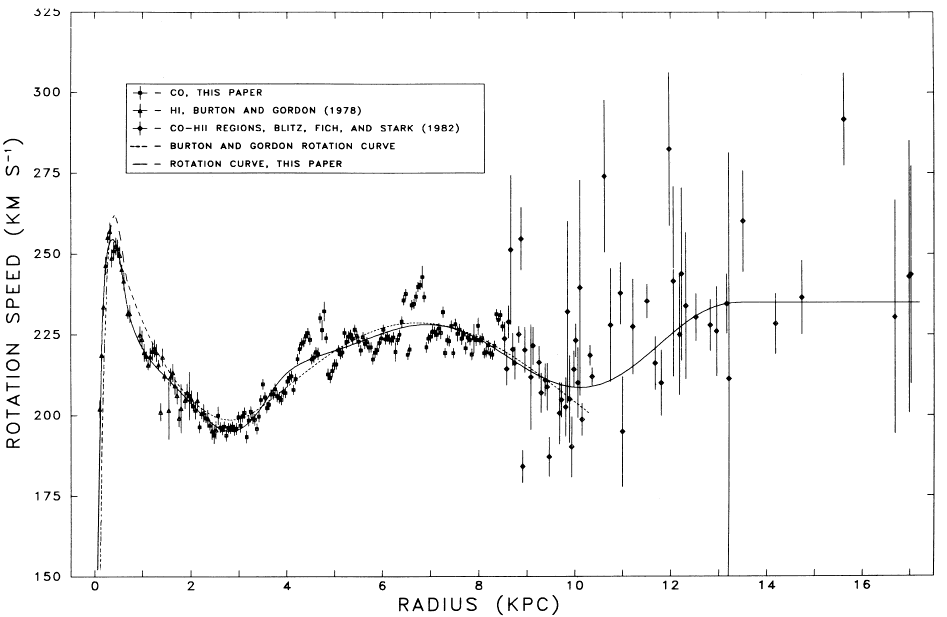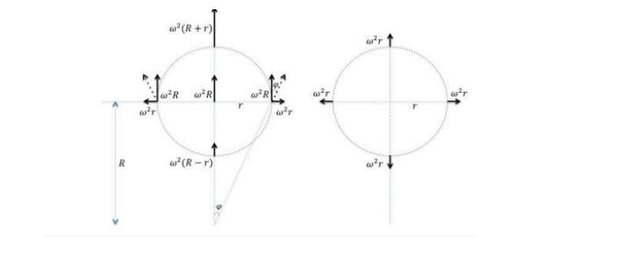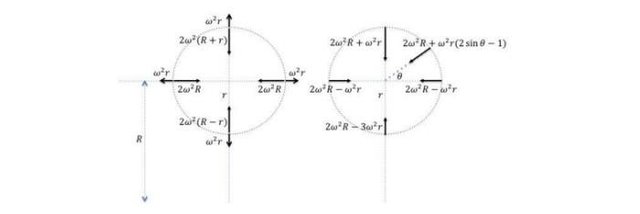Alternates to Dark Matter: Exploring Goedel's Rotating Universe
INTRODUCTION
Rotational curves of spiral galaxies are the main tool for determining mass distribution in spiral galaxies. They provide us fundamental information necessary for understanding dynamics, evolution and formation of spiral galaxies. In the following text I will describe the methods used for determining rotation velocity, present the results and describe problems and potential solutions.
If we go back to Solar system for a moment, we will notice that the velocity of planet's revolution is decreasing with increasing distance.This is simple consequence of Kepler's laws.
Source Quora.com
Just have in mind, when we talk about rotation of planets we think of actual rotation of planet around its own axis, but when we talk about rotation of Solar system we are thinking of revolution of stars around Sun. The fact that speed of revolution is decreasing with distance is completely in agreement with gravitation theory.
But when it comes to galaxies, situation is somewhat different. In typical spiral galaxy stars are revolving around galactic center. It was expected that stars further away from the center are going to revolve with lower velocities. But, in all observed galaxies, rotational velocity of stars DOES NOT change with the distance!

Source Wikipedia.com
The most simple and the most logical explanation is that somewhere out there is additional mass we are not aware of it, acting on stars, and giving them observed velocities through gravitational interaction. This matter is distributed throughout whole galaxy, and actually it's a lot more massive than all stars and gas in galaxy. The problem is we were not able to detect this matter, and yet there is so much of it out there, so our conclusion is that this matter does not interact with anything anyhow, except for gravitational interaction,. Thus, it's named DARK MATTER.
MEASUREMENTS
We use different method to determine exact values. I will just list these methods, without going into details, because detailed explanation of measurements methods is not the main topic of this article nor is of crucial importance for understanding of following text.
- Hα and optical measurements
For optical measurements we use spectrographs. Traditional instruments are long slit spectrographs which use emission lines for deriving velocities of stars.
Modern spectrographs, such as Fabry-Perot spectrographs is an integral field spectrograph, and offers more information on velocities. Most observed emission lines are Hα, NaII, SII. - HI line
HI lines are extremely powerful tool for determining stars velocity. Reason is simple, neutral hydrogen (HI) spreads way beyond the visible component of galaxy. This means HI can be found way beyond the furthest stars, and can give us the most important information on galaxy kinematics. Rotational velocity of the outermost parts can be determined exclusively using HI measurements.

Source Wikipedia.com
- CO line
The last resource, of significant importance, is CO line. Lines created in rotational transitions in CO molecule in mm domain, are extremely important for describing kinematics of inner parts of the galaxy. Inner part are rich in dust component, and dust extinction on wavelengths characterized by CO lines is negligible. In this way, original information from inner parts of the galaxy reach an observer on the planet Earth unaltered.
ROTATION OF INNER REGIONS
Central regions are still unknown places. Optical spectroscopy is often facing dust extinction problems. This problems are reduced in CO lines wavelengths. Thus, we use combination of optical spectroscopy and CO lines to derive the best possible results.
Let's see the example of Milky Way central region.
Studying proper motions in near infra-red domain we learn that stars' velocities in inner 1 parsec are huge, which is an obvious indicator of huge mass concentrated in the very center of the galaxy, which is explained by existence of central supermassive black hole. Measuring rotational curve by using combination of CO and optical spectroscopy show steady rise in first 100 parsecs, and even reaching maximum speeds of 250 km/s, at 300 parsecs. Then, there is decreasing part, as expected, reaching minimum of 200 km/s at 3 kiloparsecs, and then there is unexpected flat part. In following image you can see graph from original research.

Source Clemens, 1985
Rotation of disc, is representation of mass distribution in disc. It is noticed that the most luminous galaxies have small decline of velocities in outer parts of disc. Discs with regular luminosity have constant value of velocities, while the least luminous galaxies have small rise in rotational velocity.
HALO ROTATION
First galaxy rotation curve was derived in 1970, using measurements of 60 HI regions, and unexplained discrepancy was obvious. Galaxy rotation curve kept its flat form up to 24 kiloparsecs, where last HI region was observed. In order to keep the curve flat, mass should increase, and only thing that was found in outer regions was neutral hydrogen, which was not enough to support growing mass problem. Nothing else was found over there up to date, despite developments of telescopes and astronomical equipment.
Below you can see the original rotational curve derivation.

M31 rotation curve (Roberts & Whitehurst, 1975)
Later, it was shown that this galaxy is keeping its flat rotational line up to even 50 kiloparsecs. The same features were noticed with all other galaxies.
With years of research, it was concluded that the galaxy is immersed in invisible dark halo. Halo must be extremely massive to provide such rotational velocities. At the same time, halo particles are invisible and do not interact with anything, except for gravitational interaction (because all massive objects have certain gravitational influence).
NATURE OF DARK MATTER
The existence of dark matter was derived by measuring its gravitational effect on visible matter. Without huge mass in halo, which looks like is empty, rotational curve would decrease in regions far away from the center. In following picture you can see curves for different galaxies.

Source Caltech.edu
There are two most popular explanations of dark matter nature.
First is that dark matter particles are WIMPs (weakly interactive massive particles-obviously describing all needed characteristics of dark matter).
Second explanation is MACHO (massive compact halo objects). Actually there are a few candidates for MACHO, such as black holes or dark dwarf stars. For black holes scenario, unexplained part of the story is how those black holes got there, because it is known that galaxies are located in galaxy centers.
For dark dwarf stars, the problem is that the Universe is not old enough to contain needed numbers of this objects to support observational evidence.
ROTATION OF THE UNIVERSE
This idea is mathematically challenging even for people from science, so I will try to explain the basic idea and effects without using any formulas.
This idea is not new, it dates back 70 years ago when Gamow first discussed this topic. After that, famous Kurt Goedel solved Einstein's general relativity equations in case of rotating Universe, and got some really interesting results.
His rotating Universe had certain features that would lead to distortion of reality, such as closed timelike curves. This means that if we would be living in such Universe, we would not be able to tell if certain event happened before or after given moment. Can you imagine this? Well, probably no.
Also rotation of the Universe would produce certain contradictions such as the shape of absolute future, or light cone paradox. But, this topics are way beyond my understanding of theoretical physics (I'm just an astrophysicIst!).
If you are interested in this topic, here you can find excellent video on Goedel's Universe and visualization of it.
At that time, galaxy rotation curves, dark matter, dark energy were unknown terms. Interesting part is to check the effects of rotating Universe on galactic rotation, and to see if there are any inertial effects caused by cosmic rotation we can take into account and explain dark matter, without dark matter!
Let's start.
Basic idea is that cosmic rotation is producing centrifugal and Coriolis force on cosmic scales.
So, we have three relevant forces.
Let's see graphically effects of cosmic centrifugal force on galaxy that has circular orbit around the center of the Universe (although, our understanding of the Universe implies that actual center of the Universe doesn't exist, but for a moment forget about this, and just imagine we are living in Goedel's Universe.)

Source (Zorba 2012)
Let's discuss the image above. Left image shows effects of cosmic centrifugal on galaxy that is moving in circular orbit, at certain distance R from the center of cosmic rotation. Those expressions look complicated!
Right image show the effects of cosmic centrifugal force, but this time observed from the center of mass of galaxy. This looks a lot better! We see that effects of cosmic centrifugal force depend on only two parameters, w is angular rotational velocity of the Universe and r which is distance from center of mass.This looks pretty simple.
Important note, centrifugal force is antigravitational force, in other words, it acts on particles in opposite direction of gravitational force.
But don't forget there is another force, caused by cosmic rotation, and that is Coriolis force.

Source (Zorba 2012)
Let's analyze the image above. Left image show combined effects of centrifugal and Coriolis force. We can notice that Coriolis force is centripetal force, in other words it acts the same way gravity acts, towards the center of the galaxy.
Right image show actual effect of combined cosmic centrifugal and Coriolis force. We can see that net force is centripetal, acts towards the center.
This is good, because if we add gravity now, net force will be bigger than gravity alone, thus higher velocities of stars are possible, than theory of gravity predicts!
Now we reach key part of this theory. Parameter w shows up everywhere. This parameter is angular rotational velocity. Let's set this parameter to be equal to H (Hubble constant).
The Hubble Constant is the unit of measurement used to describe the expansion of the universe.

After lengthy calculations we reach this final expression.
Let's analyse this, to see how this explains rotational curves.
We can see that for the particles that are close to the center (small r) third term on the left side is dominant. This is actually classical gravitation. So first part of galactic rotation curve stays the same as usual, and that's good.
With increasing distance (increasing r) gravitation term is becoming less influential and first term is taking over.This term is due to Coriolis force. And at the huge distances, second term becomes dominant, the term that exists due to centrifugal force.
It's important to notice that Coriolis force has constant value, and all rotational curves have this feature (recall the flat unexplained line) !!
So actually, rotational Universe explains rotational curve paradox. Dark matter is actually just inertial effect due to cosmic rotation!
But, to bad, we do not live in an rotational Universe...
I hope you enjoyed this article. Although initial conditions were flawed, this is really interesting conclusion to derive, and to see how weird and mysterious our Universe could be.
“There is a theory which states that if ever anyone discovers exactly what the Universe is for and why it is here, it will instantly disappear and be replaced by something even more bizarre and inexplicable.
There is another theory which states that this has already happened.”
Douglas Adams
Sources used
https://arxiv.org/pdf/1210.3021.pdf
https://en.wikipedia.org/wiki/G%C3%B6del_metric
Wow, my audience is much more intelligent than I could have ever expected. Intriguing subject matter. I really expected to cater to the Aqua Teen Hunger Force crowd. I am going to call this a win for flying robots. Thanks again for giving me a boost in the first week. I will be following you for the times I want to swim in the deep end.
If Michio Kaku shows up in my comments section, I will really need to rethink my reality.
thanks bro :)
Have always been interested in astrophysics; I think have found the perfect account on Steemit to learn all I can about it. Waiting for the next post.
thank you :)